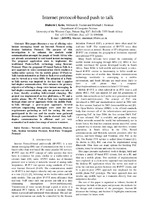Internet protocol-based push to talk
Date
2010Author
Kobo, Hlabishi Isaac
Tucker, William David
Norman, Michael
Metadata
Show full item recordAbstract
This paper discusses a way of offering voice instant messaging based on Internet Protocol using Session Initiation Protocol. The purpose of this investigation is to enhance the modern social communication amongst the people of South Africa who are already accustomed to text-based instant messaging. The proposed application aims to implement the traditional Push-to-Talk technology using Internet Protocol. Thus the proposed IP-based Push-to-Talk is a new approach to voice communication which emulates a walkie-talkie system. On the mobile phone IP-Push-to-Talk herein referred to as Push-to-Talk over a cell phone can be viewed as a voice SMS. The adoption of a Push-to-Talk service was inspired by the fact that it applies half-duplex communication. This enhances the primary objective of offering a cheap voice instant messaging. In half-duplex communication, only one person can talk at a time, thereby avoiding bidirectional charging. The project was implemented on two platforms, a PC and a mobile phone. The PC Push-to-Talk was implemented through client server approach whilst the mobile Push-to-Talk through a peer-to-peer approach. Several software engineering strategies were used for user requirements gathering as well for testing. Six users participated in the test and the results were gathered through questionnaires. The results showed that, half-duplex communication is efficient and yet very economical as it makes less usage of system resources.

